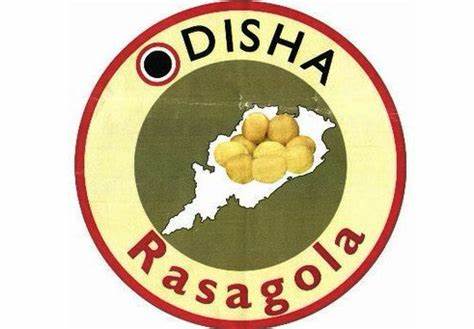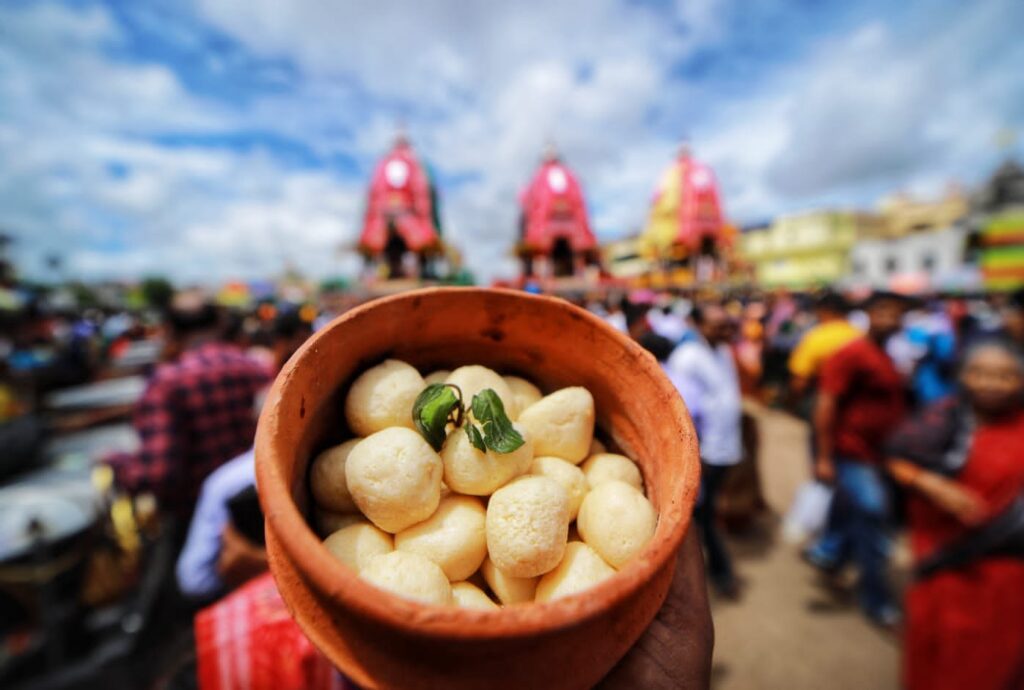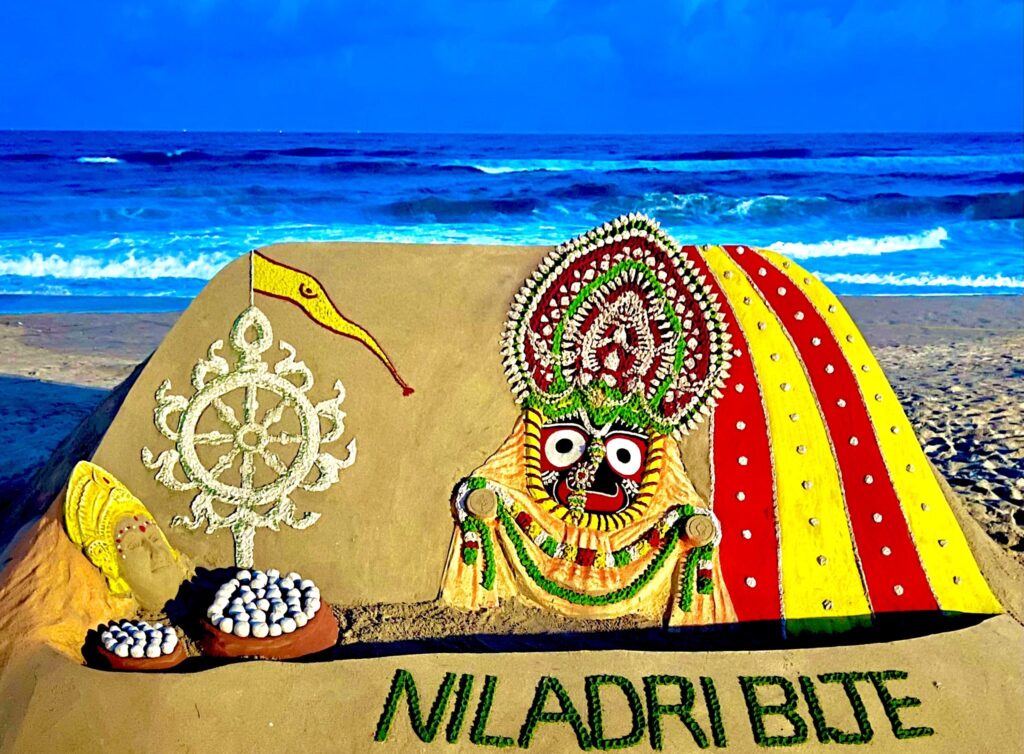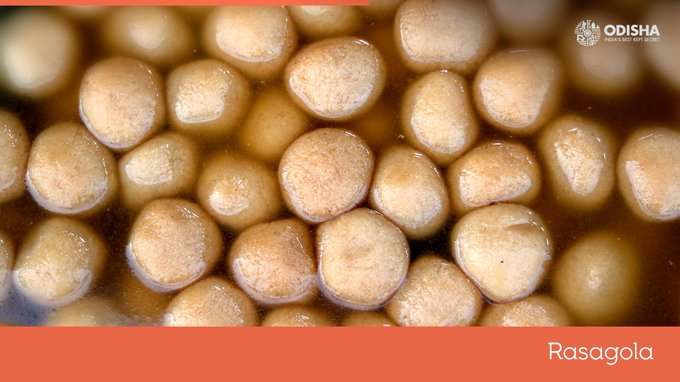Pradeep Kumar Panda
The Odisha Small Industries Corporation Ltd and Utkala Mishtanna Byabasayee Samiti had filed the applications with the GI Registry wayback in 2019 for the award of the GI tag for Odisha Rasagola and received GI Tag. The Chennai-based government regulator, Geographical Indication (GI) Registry tasked to settle commercial disputes on geographical origins has now called West Bengal Government for a hearing on an Odisha petitioner’s complaint that Bengal furnished false evidence and data in order to claim Rasagola as its own.
The registration was conferred to ‘Odisha Rasagola’ under Section 16 (I) or of authorized Section 17 (3)(c) of Geographical Indication of Goods (Registration and Protection) Act 1999 on Monday. The GI number 612 has been registered in favour of the Odisha Small Industries Corporation Limited (OSIC Limited) and Utkal MistannaByabasayee Samiti.

Odisha’s Ramesh Chandra Sahoo, who heads an NGO called Regional Development Trust, had in February 2018 questioned the basis following which the Chennai-based GI Registry granted BanglarRasogola a Bengal Geographical Indication tag in November 2017.
The Chennai regulator now wants the West Bengal Government to appear before it and prove its case, failing which, the registry will decide the matter on the basis of law and documents before it. Sahoo says he had demanded cancellation of the GI tag given to Bangla Rasagulla in West Bengal.
The GI certification describes Odisha Rasagola, as a sweet dumpling known for its juicy and non-chewy feel that can be “swallowed without teeth pressure” and Banglar Rasagola as pure white, spongy ball of “Chhana” dipped in light sugar syrup that had a fluffy smooth texture with less chewiness character.
However, Odisha rejects the Bengal argument that Bengal Rasagolas were derived from Kolkata resident Nobin Chandra Das’s invention called “Rasagulla” and were completely different from Odisha Rasagola.
Odisha claims historic and legitimate ownership over the popular delicacy. Rasagola, according to the Odisha government, was served in the 11th century Lord Jagannath temple, much before Bengal knew about it.
Odisha had cited several references to the sweet in historical documents and mythologies like Dandi Ramayana, a version of the epic adapted by Balaram Das in the 16thcentury. It is said in ‘Ajodhya Kanda’ of Dandi Ramayana, that there were descriptions of Bharata and Shatrughna going to the forest to bring Lord Rama back and stopping at the abode of sage Bharadwaj, where the sage served them Rasagola among several other sweets.
To buttress its claims, the Odisha government showed the Record of Rights of the 11thcentury Jagannath temple which said in the age-old ritual of “NiladriBije”, the sweet was traditionally offered to Goddess Lakshmi on behalf of Lord Jagannath.
Odisha has retorted strongly by celebrating Rasagola Day for the first time on 30th July 2015. However, one may create a certain amount of public awareness by celebrating such a day once a year, but that cannot be the valid evidence on the basis of which it can be said Rasagola belongs to Odisha.
No sooner than the debate got stirred about whether Rasagola belonged to Odisha or Bengal, Haripada Bhowmik, a Bengali scholar who researches culture, wrote a book really fast, RasagolaBanglarJagatmatanoAbis
There is no doubt about the fact that Chena has its root in the Sanskrit word ‘chhina’ (Literally, which has been cut). In Odia, the phrase used for this is, ‘Chena chhindiba’. Pandit Gopinath Nandasharma has also said that Chena is derived from the word chhina. In his view, it is an aberration of milk.
On the other hand, Bhowmik has used it in a negative sense. The apt meaning of ‘bikara’ is transformation. In that sense, yoghurt, butter, clarified butter—all these are new forms of milk. So, the way Bhowmik has made out such a perverted meaning of Chena on the basis of the word ‘chhina’ is completely meaningless.
He has said that Chena (cottage cheese) is prepared by curdling milk. Since it is made by curdling milk with the help of an acidic substance it is almost like a murder! in a complex web of puritanical practices, it becomes na-paka, (something impure and hence not to be eaten) by the non-Bengali Indians.
That is why the main ingredient of sweets is milk all over India except in Bengal. Bengal has not kept ‘Chena’ aside as impure. On the other hand, it has prepared a variety of sweets using Chena.’ Bhowmik has not restrained himself from saying this. He has gone a step ahead and also said, ‘Chena was regarded as a dead substance’. ‘Chena is dead milk—and hence, it is discarded as a dead form.’
Bhowmik also mentioned in his book that since Chena is a perverted form of milk it is not worthy of gods, that is why it is prohibited at temples. He has taken the Achaya side. However, many delicacies prepared from Chena are made as food offerings not only at Lord Jagannath temple, Puri but at numberless temples since time immemorial.

In Lord Jagannatha’s ‘Anasara’ (when Lord Jagannath falls ill) and ‘MahaAnasara’ during the ‘Nabakalebara’ (the year in which Lord Jagannath takes a new wooden form), chhena is part of many food delicacies at these secret rituals. Besides, chhena is a main ingredient during the car festival, at Mausima temple’s poda pitha (pancake made by roasting a batter of rice and black gram mixed with chhena and grated coconut), and in other such pancakes during the Chandan Yatra festival.
Even in the mid-day offering, chhena is put in condensed milk. Therefore, it is absolutely clear that Indians knew the preparation of cottage cheese even before the Portuguese or the French arrived in India. In any other part of India, it may be regarded as a ‘perverted form of milk’ and not offered at temples, but it was not prohibited in temples in Odisha.
It was used in the preparation of various food offerings at Lord Jagannath temple since time immemorial. In Sri Mandira Sattwalipi (Record of Rites, Lord Jagannath Temple, Puri), many delicacies made with chhena have been mentioned.
It is clear from the discussion of earlier topics, the impure chhena did not become pure because of Sri Chaitanya nor did it come to Odisha from Bengal courtesy. Chhena was always a favourite delicacy in Odisha, and it has been regarded as a pure ingredient in food offerings made to deities.
It is an interesting history in itself — how Chhena became Gola (balls of cottage cheese) and acquired rasa (syrup) and became Rasagola (balls of cottage cheese put in syrup).
It is clear from the above-mentioned stories that be it Phulia or Shantipur or Bagh bazaar, the Rasagola produced during that time was known as delaRasagola. Because it was not soft like it is now. It was crude as a slab of earth. Later, Navin Chandra Das, who had started his career as an apprentice at Kali Indra shop, gave this hard sweet its present soft form. That is referred to as ‘Sponge Rasagola’ in Kolkata.
There is a story prevalent in Kolkata that Chhena Bada is the ancestral form of Rasagola. From the description of its recipe found in books on food in Bengal, it can be compared with Chhena Jhili of Nimapara or Rasabali of Kendrapara, Odisha. It is also sweet like Rasagola. It is one of the items in the chhapan bhog (fifty-six items of food) at Lord Jagannath temple, Puri. There is no doubt about the fact that Jhilli or Rasabali was prevalent much before Chhena-bara of Kolkata.
So, if Chhena-Bada of Bengal is an older form of Rasagola, the same variety of sweets such as chhena jhili and Rasabali of Odisha are even much older forms of Rasagola. In this context, it can be mentioned that there is a long tradition of preparing another sweet of the same variety called Rasa bara which is found in western Odisha. The Purnachandra Odia Bhasakosa confirms it as a sweet of Odisha.
Jaggery was the sweetener used in Rasagola before the use of sugar. In this context, we have mentioned the existence of words such as Rasa kora, and chhena-Bada in the Purnachandra Odia Bhashakosha. But all these similar-sounding words don’t guarantee confirmation in favour of Rasagola.
The Dandi Ramayana offers confirmation in this regard. In Pundit Surjya Narayan Das’ Central Sahitya Akademi award-winning book Odia Sahityara Itihasa (History of Odia Literature) Part I,28 it is written that there is the mention of Rasagola in Balaram Das’ Dandi Ramayana.
There’s no dearth of lore, memoirs and stories centring on Rasagola in Odisha. But unlike in Bengal, literature on Rasagola has not been compiled systematically in Odisha. Starting from Sarala Mahabharata to Dandi Ramayana, Ambika Bilasa, and Bidagdha Chintamani, Odisha food culture is amply described in all these books. In this context, especially notable is in Purnachandra Odia Bhashakosha, there is alien ‘Sankalparamandahela Satya Rasagola’ under the entry, Rasagola. In the description, it is mentioned ‘Chintamani.’
Tulasi Ojha, an eminent scholar, has written in an essay, ‘
Sudasha Brata is worship offered to and fast observed by Odia women to appease goddess Lakshmi on a Thursday. According to traditional rules of osha bratas, it is customary to offer goddess Lakshmi balls of chhena mixed with jaggery on this day. According to Ojha, as chhena-manda and chhena gula offerings are very dear to Goddess Lakshmi, Lord Jagannath brings Rasagola with him to appease an angry Lakshmi on the day he returns to his abode on the last day of the car festival.
Rasagola has been offered to appease Goddess Lakshmi on the day of NiladriBije for several centuries at Lord Jagannath temple, Puri. But many argue that the use of Rasagola is not mentioned in Satwa Lipi (Record of Rites of Lord Jagannath Temple, Puri). But then, even if there is no mention of Rasagola in particular, there is mention of ‘bhoga Bidhi’ (manual for food offerings) in the Sattwalipi.

Earlier, this ritual was celebrated on the twelfth day of the full moon phase of the month Aashaadha. Therefore, the procedure has been mentioned in the context of ‘Dwadashi-NiladriBije’. In this, it is written “Bada Thakurand Subhadra are brought to the throne. While they were brought to the Suasari temple, Pati Mohapatra offered worship to them. In Jagamohan, the Holy Deities are also offered worship.
Similarly, it is written in the context of Lord Jagannath’s ‘Niladri Bije’: When the door opens, and Lord Jagannath arrives near the place where Lakshmi is already waiting, Bhitarachha Mohapatra Sevak unties the knot of the ritual of marriage. They are offered worship. After this, Lord Jagannath sits on his throne.
The significance of this procedure is that when Balabhadra and Subhadra are offered different delicacies at this time, Lord Jagannath is offered Rasagola. Though there is no specific mention of the food offered here, it can be said without doubt that it is Rasagola. Traditionally Bhitarachha Mohapatra prepares the Rasagola in a sattvic manner at his home and offers that to Lakshmi on behalf of Lord Jagannath.
In the Bhitarachha practice code in Sattwalipi, this finds a particular mention. Regarding the ‘Bhitarachhaseva’ on the day of ‘Niladri bije’, it has been mentioned that ‘this servitor offers light manohi at the meeting altar, makes a light offering to garuda, while Lord Jagannath descends from the chariot and goes to sit on the jewelled throne. While the knot of the marriage to Rukmini is untied, he is offered dahi Pati, ghasa, bidiamanohi and Bhog offering. Since only Rasagola has been offered by Bhitarachha Mohapatra for ages, even though it is not written specifically, it is ‘Rasagola.’ There is no mention of any other food offering nor has any other sweet ever been seen to be offered.
The mutts involved in Lord Jagannath’s seva and worshipping such as Bada Odia mutt, Radhaballav mutt, Cuttaki mutt, Newla Das mutt and Radhashyam mutt make Rasagola offering for the last hundred to three hundred years. In this context, an eminent scholar on the tradition of ‘Puri mutts’, Bhaskar Mishra makes special mention of Raghab Das mutt.
He had made an elaborate discussion on this in the journal Pourusha and says, ‘This is the only mutt which brings Rasagola to offer to Lord Jagannath. A servitor offers it to Lord Jagannath after the Rukmini marriage knot is untied on behalf of the mutt. This tradition is about three hundred years old.” An important piece of information regarding this is, that while Bhowmik claims that the chhena offering was first made to Lord Jagannath after king Prataparudra Dev came under the influence of Sri Chaitanya, no such offering is made at Sri Chaitanya Gaudiya mutt in Puri on that day.
Similarly, at the time of Anasara of Lord Jagannath (when he’s down with fever), Sri Chaitanya didn’t get to have a glimpse of Lord Jagannath and went to have a glimpse of Sri Alarnath at the Alarnathpith nearby, but there is no practice of making Rasagola offering there.
The favourite offering is Khiri (a little amount of boiled rice added to sweetened and condensed milk). On the other hand, Bansidhar Goswami, the head of the Bada Odia mutt established by Jagannath Das in Baseli Sahi of Puri, says: According to the daily and annual procedure and manual of the mutt, Rasagola is offered as bhoga at least more than three hundred years in the mutt.
The question arises, while Anangabhima Deva introduced new food offerings at Lord Jagannath Temple, did Rasagola find a place in it? In this regard, we can take the help of Madalapanji. In the hand-written manuscript of Madala Panji which is preserved in Odisha State Archives, there is a description regarding the food offering made during the reign of Anangabhima Dev—” In the morning offering… the food will form a mountain…pancakes such as kakara, arisa, pili, apamala, ghola, badanadi, tipuri are decorated as trees, sarapapudi, gotika, rasakora become like flowers. Chimamanda, ripe banana, and baby coconut all will be decorated as fruits. The servitor will offer these to Lord Jagannath.“
In the book Jagannath and the Gajapati Kings of Orissa, edited by Dr.Gaganendra Nath Dash, an eminent scholar of Odia literature and Jagannath consciousness, there is mention of food offerings of Lord Jagannath quotes from ancient pothys, ‘Desha Khanja’, ‘Sevakabhiana o Sevabibarana’. In this, it has been mentioned that rasakora, Chhenaladoo, o chhenamanda are mentioned in the morning offering, Madhyannhadhupa, Sandhya dhupa. Later, all these bhogas are mentioned in the Sri mandira Sattwalipi. It may be said that all these are an earlier form of Rasagola.
Rasagola is apparently chhena ladoo or a ball of cottage cheese. The only difference is balls of chhena are boiled in sugar syrup to prepare Rasagola. Rasagola is boiled in sugar syrup whereas ‘chhenamanda’ is prepared by steaming balls of boiled rice flour stuffed with chhena.
Rasagola has been traditionally used as a ritual offering on the last day of the car festival at the time of Niladri Bije (Lord Jagannath’s return to his abode). Jagabandhu Padhi, an eminent scholar of the Jagannath cult, views the tradition to be at least 600 years; others say this must be at least 300 years.
According to customs, after Sri Balabhadra and goddess Subhadra enter the temple, the aides close the entrance door at goddess Lakshmi’s order. As he cannot enter the temple, Lord Jagannath sends a message through goddess Lakshmi’s aides. After this, Goddess Lakshmi tells her aides to open the door. According to ‘Niladri Mahotsaba’, after the aides and attendants tell her about Lord Jagannath’s sweet words and humble requests, Lakshmi gives up her affected anger and orders them to open the door in an elated mood. And then the aides go quickly and tell Lakshmi happily.
Lord Jagannath who had been away for nine days, appeared at the goddess’s door, you hear! We have closed the doors. Outside, the lord is waiting. And he is requesting me and you. How much I cannot say. Hearing such nectar words Goddess is elated and happy She’s never one hard-hearted She is innocent, chaste, and calm. So unable to hold anger in her heart She orders her aides to open the doors and let the Lord come inside.
According to the custom of Niladri Bije, after this, the servitors role-playing as aides go and open the doors and the lord walks into the temple. In front of the bhandara room, Lakshmi and Narayana meet and the marriage knot (gainthala) is untied. At the time of this divine meeting, Lord Jagannath offers Rasagola to Lakshmi to appease her.
One of the important aspects of this ‘gainthala’ knot is on the eleventh day of the full moon phase in the month of Jyeshta (lunar month corresponding approximately to 15 March-15 April), the wedding ceremony takes place after the abduction of Rukmini. Immediately after that Lord Jagannath joins the Snana yatra (bathing festival) and after the bath got down with a fever.

And once he recovers from his fever, he gives a glimpse of his new vigour (Naba Jaubana) to devotees and goes out on a chariot accompanied by his brother and sister. That’s why the wedding knot tied earlier had not been untied. That gets untied on the day of ‘Niladri Bije’, the day he returns to his abode. The year Nabakalebara falls, there’s one speciality, the knot is tied to the old wooden Brahman, but the knot is untied from the new form.
It means, this divine, intimate ritual can only be witnessed, it can be experienced, but it is not describable. Only the devotees present there get to experience the divine feeling. Therefore, though traditionally Rasagola is made as a food offering for centuries, there’s hardly any literary work in Odia which mentions this. Bhitarachha Mohapatra, the servitor, prepares this offering at his house in a pure way. The prominent mutts too offer Rasagola to Lord Jagannath on the chariot.
The mention of Rasagola in Dandi Ramayan shows it is prevalent in Odisha for at least five hundred years. And the Sri Mandira Sattwalipi supports that it is offered on the day of Niladri Bije. This clearly proves that Odisha is the place of origin of Rasagola, and it is the traditional ritual offering when Lord Jagannath returns to his abode.
Rasagola originates and belongs to Odisha. There’s lots of information and evidence to support this claim. It is one of the traditional food offerings made to Lord Jagannath. As part of the last ritual of Rath Yatra, known as ‘Niladri Bije’ (Lord Jagannath’s return to his abode after nine days), it is offered to goddess Lakshmi on behalf of Lord Jagannath. Lord Jagannath had gone to visit his birthplace accompanied by His brother and sister for nine days, and that had made his wife, Goddess Lakshmi angry. It is, however, unfortunate that West Bengal has claimed itself to be the place of origin of Rasgulla as well as of the word ‘Rasagola’.
(Writer is an economist based in New Delhi. Views are personal)
Tags: #GeographicalIndication #Rasagola #NiladriBije #Odishasweets #Odiafoods #GItag #SpongeRasagola






















